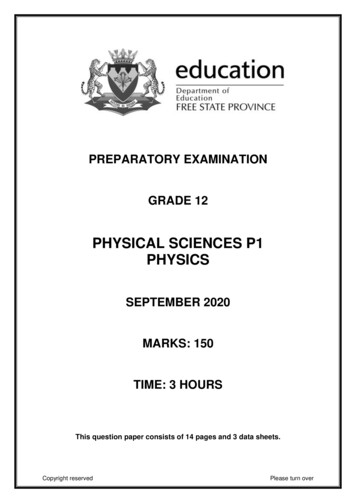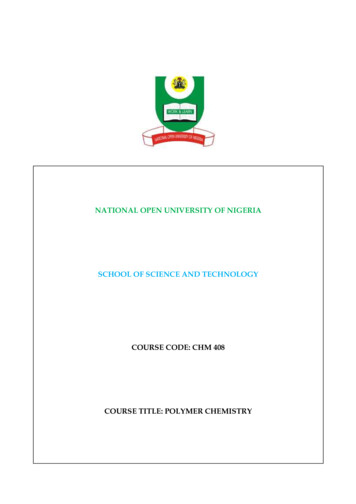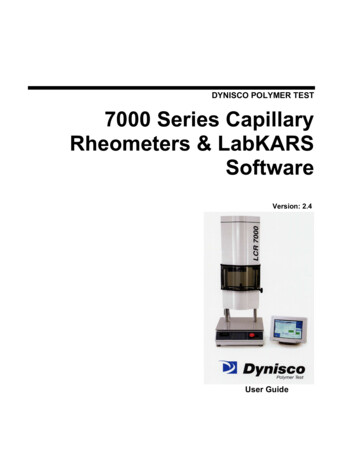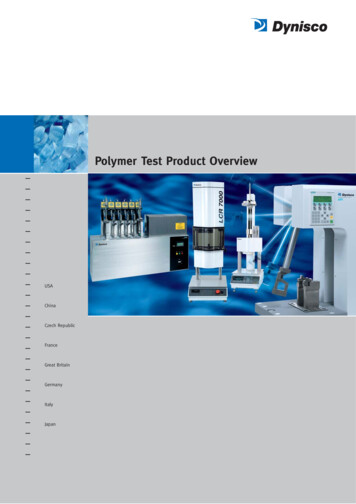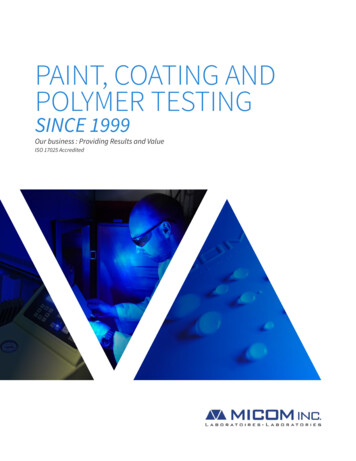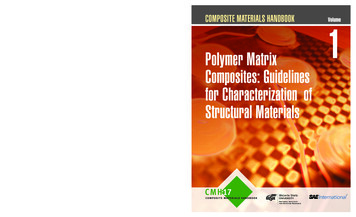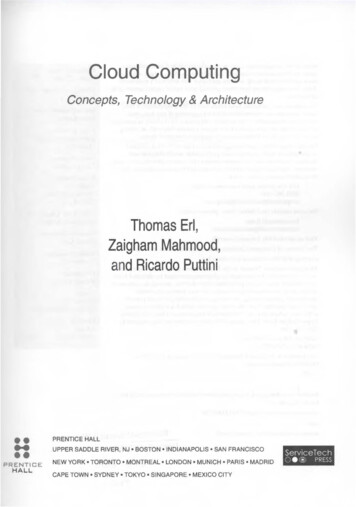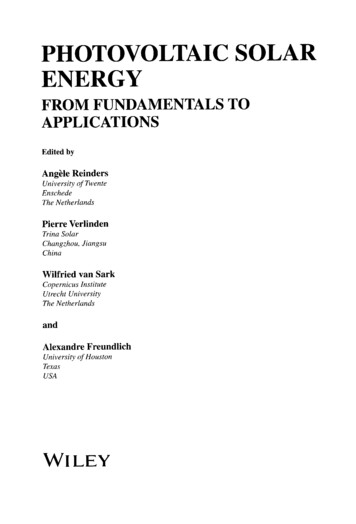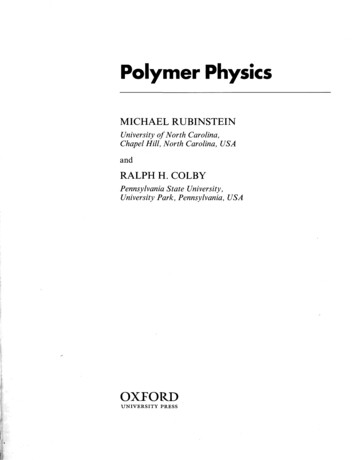
Transcription
Polymer PhysicsMICHAEL RUBINSTEINUniversity of North Carolina,Chapel Hill, North Carolina, USAandRALPH H. COLBYPennsylvania State University,University Park, Pennsylvania, USAOXPORDUNIVERSITY PRESS
ContentsIntroductionl1.11.21.31.41.5History of polymer sciencePolymer microstructureHomopolymers and heteropolymersFractal nature of polymer conformationsTypes of polymeric substances1.5.1 Polymer liquids1.5.2 Polymer solids1.5.3 Liquid crystal polymers1.6 Molar mass distributions1.6.1 Binary distributions1.6.2 Linear condensation polymers1.6.3 Linear addition polymers1.7 Molar mass measurements1.7.1 Measuring Mn by osmotic pressure1.7.2 Measuring M w by scattering1.7.3 Intrinsic viscosity1.7.4 Size exclusion chromatography1.8 26293335383945Single chain conformationsIdeal y mechanismsConformations of an ideal chainIdeal chain models2.3.1 Freely rotating chain model2.3.2 Worm-like chain model2.3.3 Hindered rotation model2.3.4 Rotational isomeric state modelRadius of gyration2.4.1 Radius of gyration of an ideal linear chain2.4.2 Radius of gyration of a rod polymer2.4.3 Radius of gyration of an ideal branched polymer(Kramers theorem)64
Contents2.52.6Distribution of end-to-end vectorsFree energy of an ideal chain2.6.1 Scaling argument for chain stretching2.6.2 Langevin dependence of elongation on force2.7 Pair correlations of an ideal chain2.8 Measurement of size by scattering2.8.1 Scattering wavevector2.8.2 Form factor2.8.3 Measuring F?% by scattering at small angles2.8.4 Debye function2.9 Summary of ideal 96Real 2125127133Excluded volume and self-avoiding walks3.1.1 Mayer/-function and excluded volume3.1.2 Flory theory of a polymer in good solvent3.2 Deforming real and ideal chains3.2.1 Polymer under tension3.2.2 Polymer under compression3.2.3 Adsorption of a single chain3.3 Temperature effects on real chains3.3.1 Scaling model of real chains3.3.2 Flory theory of a polymer in a poor solvent3.3.3 Temperature dependence of the chain size3.3.4 Second virial coefficient3.4 Distribution of end-to-end distances3.5 Scattering from dilute solutions3.6 Summary of real chainsProblemsBibliographyIIThermodynamics of blends and solutionsThermodynamics of mixing4.14.24.34.44.5Entropy of binary mixingEnergy of binary mixingEquilibrium and stabilityPhase diagramsMixtures at low compositions4.5.1 Osmotic pressure4.5.2 Polymer melts4.6 Experimental investigations of binary mixtures4.7 Summary of 54155157159163165170
ContentsixPolymer solutions1715.1 Theta solvent5.2 Poor solvent5.3 Good solvent5.3.1 Correlation length and chain size5.3.2 Osmotic pressure5.4 Semidilute theta solutions5.4.1 Correlation length5.4.2 Osmotic pressure5.5 The Alexander - de Gennes brush5.6 Multichain adsorption5.7 Measuring semidilute chain conformations5.8 Summary of polymer 184186187189190191196IIINetworks and gelationRandom branching and gelation6.1 Introduction6.1.1 Percolation around us6.1.2 Percolation in one dimension6.2 Branching without gelation6.2.1 Hyperbranched polymers6.2.2 Regular dendrimers6.3 Gelation: concepts and definitions6.4 Mean-field model of gelation6.4.1 Gel point6.4.2 Sol and gel fractions6.4.3 Number-average molar mass below the gel point6.4.4 Weight-average molar mass below the gel point6.4.5 Molar mass distribution6.4.6 Size of ideal randomly branched polymers6.5 Scaling model of gelation6.5.1 Molar mass distribution and gel fraction6.5.2 Cutoff functions6.5.3 Size and overlap of randomly branched polymers6.5.4 Vulcanization universality class6.6 Characterization of branching and gelation6.7 Summary of branching and gelationProblemsBibliographyNetworks and gels7.1 Thermodynamics of rubbers7.1.1 Flory construction7.2 Unentangled rubber 20224227227231234237241244247252253253255255
Contents7.2.1 Affine network model7.2.2 Phantom network model7.2.3 Finite extensibility7.3 Entangled rubber elasticity7.3.1 Chain entanglements and the Edwards tube model7.3.2 The Mooney-Rivlin model7.3.3 Constrained fluctuations models7.4 Swelling of polymer gels7.4.1 Swelling in Insolvents7.4.2 Swelling in athermal solvents7.4.3 Swelling in good solvents7.5 Networks in the gelation regime7.6 Linear viscoelasticity7.6.1 Stress relaxation after a step strain7.6.2 The Boltzmann superposition principle7.6.3 Steady shear7.6.4 Creep and creep recovery7.6.5 Oscillatory shear7.7 Summary of networks and entangled polymer 333334334339340341345350352360Rouse modelZimm modelIntrinsic viscosityRelaxation modes8.4.1 Rouse modes8.4.2 Zimm modes8.5 Semidilute unentangled solutions8.6 Modes of a semiflexible chain8.6.1 Bending energy and dynamics8.6.2 Tensile modulus and stress relaxation8.7 Temperature dependence of dynamics8.7.1 Time-temperature superposition8.7.2 Transition zone of polymer melts8.7.3 Short linear polymer melts8.8 Randomly branched polymers8.9 Dynamic scattering8.10 Summary of unentangled dynamicsProblemsBibliography
9ContentsxiEntangled polymer ments in polymer meltsReptation in polymer melts9.2.1 Relaxation times and diffusion9.2.2 Stress relaxation and viscosity9.3 Reptation in semidilute solutions9.3.1 Length scales9.3.2 Entanglement concentration9.3.3 Plateau modulus9.3.4 Relaxation times and diffusion9.3.5 Stress relaxation and viscosity9.4 Dynamics of a single entangled chain9.4.1 Chain in an array of fixed obstacles9.4.2 Entangled star polymers9.4.3 H-polymers and combs9.4.4 Monomer displacement in entangled linear melts9.4.5 Tube length fluctuations9.5 Many-chain effects: constraint release9.5.1 Relaxation times and diffusion9.5.2 Stress relaxation9.6 Computer simulations in polymer physics9.6.1 Molecular dynamics9.6.2 Monte Carlo9.7 Summary of entangled dynamicsProblemsBibliographyNotations423Index433
Polymer Physics MICHAEL RUBINSTEIN University of North Carolina, Chapel Hill, North Carolina, USA and RALPH H. COLBY Pennsylvania State University, University Park, Pennsylvania, USA OXPORD UNIVERSITY PRESS

